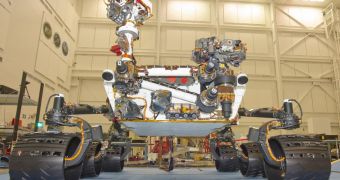The next rover to launch for the Red Planet is currently being put through its paces at a California facility, as its designers and constructors want to ensure that it can successfully withstand the harsh conditions of the Martian environment.
There are numerous new technologies that went into the robot, now called Curiosity. It is a part of the highly-innovative Mars Science Laboratory (MSL) mission, which includes an advanced landing system, novel heat shields and so on.
The rover is also the largest ever constructed. Tipping the scale at nearly a ton, and powered by a nuclear engine, Curiosity is the most complex scientific instrument ever deployed on the surface of the Red Planet, NASA says.
Currently, the machine is in the last stages of assembly at the NASA Jet Propulsion Laboratory (JPL), in Pasadena, California. Experts here manage the mission for the space agency's Science Mission Directorate (SMD), at NASA Headquarters, in Washington DC.
In order to assess its readiness, JPL experts are now putting the rover through a variety of mobility tests, which primarily deal with figuring out how well the machine's robotic arm operates, and also with how well the massive robot drives around.
The “drive tests” are being performed inside the JPL Spacecraft Assembly Facility (SAF), which recently turned 50. Thus far, the robot appears to be performing within the specified parameters.
After the assessment stage of the construction process is finished, the machine is scheduled to be shipped to the NASA Kennedy Space Center (KSC), in Florida. This is scheduled to happen later this month, JPL mission planners say.
While at the KSC, the rover will be put through additional tests, and will then be integrated with its aeroshell and other components. Once this is complete, it will be shipped “next door” to the Cape Canaveral Air Force Station (CCAFS).
A launch window is opened between November 25 and December 18. If the rover cannot launch then, it will have to wait for more than two years until the next window opens, in late 2013 – early 2014.

 14 DAY TRIAL //
14 DAY TRIAL //